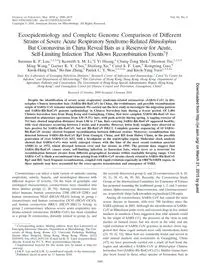
2010 Ecoepidemiology and Complete Genome Comparison of Different Strains of Severe Acute Respiratory Syndrome-Related Rh PDF
Preview 2010 Ecoepidemiology and Complete Genome Comparison of Different Strains of Severe Acute Respiratory Syndrome-Related Rh
JOURNAL OF VIROLOGY, Mar. 2010, p. 2808–2819 Vol. 84, No. 6 0022-538X/10/$12.00 doi:10.1128/JVI.02219-09 Copyright © 2010, American Society for Microbiology. All Rights Reserved. Ecoepidemiology and Complete Genome Comparison of Different Strains of Severe Acute Respiratory Syndrome-Related Rhinolophus Bat Coronavirus in China Reveal Bats as a Reservoir for Acute, Self-Limiting Infection That Allows Recombination Events�† Susanna K. P. Lau,1,2,3,4‡ Kenneth S. M. Li,4‡ Yi Huang,4 Chung-Tong Shek,5 Herman Tse,1,2,3,4 Ming Wang,6 Garnet K. Y. Choi,4 Huifang Xu,6 Carol S. F. Lam,4 Rongtong Guo,6 Kwok-Hung Chan,4 Bo-Jian Zheng,4 Patrick C. Y. Woo,1,2,3,4* and Kwok-Yung Yuen1,2,3,4* State Key Laboratory of Emerging Infectious Diseases,1 Research Centre of Infection and Immunology,2 Carol Yu Centre for Infection,3 and Department of Microbiology,4 The University of Hong Kong, Hong Kong, Hong Kong; Department of Agriculture, Fisheries and Conservation, The Government of Hong Kong Special Administrative Region, Hong Kong, Hong Kong5; and Guangzhou Center for Disease Control and Prevention, Guangzhou, China6 Received 21 October 2009/Accepted 3 January 2010 Despite the identification of severe acute respiratory syndrome-related coronavirus (SARSr-CoV) in Rhi- nolophus Chinese horseshoe bats (SARSr-Rh-BatCoV) in China, the evolutionary and possible recombination origin of SARSr-CoV remains undetermined. We carried out the first study to investigate the migration pattern and SARSr-Rh-BatCoV genome epidemiology in Chinese horseshoe bats during a 4-year period. Of 1,401 Chinese horseshoe bats from Hong Kong and Guangdong, China, that were sampled, SARSr-Rh-BatCoV was detected in alimentary specimens from 130 (9.3%) bats, with peak activity during spring. A tagging exercise of 511 bats showed migration distances from 1.86 to 17 km. Bats carrying SARSr-Rh-BatCoV appeared healthy, with viral clearance occurring between 2 weeks and 4 months. However, lower body weights were observed in bats positive for SARSr-Rh-BatCoV, but not Rh-BatCoV HKU2. Complete genome sequencing of 10 SARSr- Rh-BatCoV strains showed frequent recombination between different strains. Moreover, recombination was detected between SARSr-Rh-BatCoV Rp3 from Guangxi, China, and Rf1 from Hubei, China, in the possible generation of civet SARSr-CoV SZ3, with a breakpoint at the nsp16/spike region. Molecular clock analysis showed that SARSr-CoVs were newly emerged viruses with the time of the most recent common ancestor (tMRCA) at 1972, which diverged between civet and bat strains in 1995. The present data suggest that SARSr-Rh-BatCoV causes acute, self-limiting infection in horseshoe bats, which serve as a reservoir for recombination between strains from different geographical locations within reachable foraging range. Civet SARSr-CoV is likely a recombinant virus arising from SARSr-CoV strains closely related to SARSr-Rh-BatCoV Rp3 and Rf1. Such frequent recombination, coupled with rapid evolution especially in ORF7b/ORF8 region, in these animals may have accounted for the cross-species transmission and emergence of SARS. Coronaviruses can infect a wide variety of animals, causing respiratory, enteric, hepatic, and neurological diseases with different degrees of severity. On the basis of genotypic and serological characteristics, coronaviruses were classified into three distinct groups (2, 20, 54). Among coronaviruses that infect humans, human coronavirus 229E (HCoV-229E) and human coronavirus NL63 (HCoV-NL63) belong to group 1 coronaviruses and human coronavirus OC43 (HCoV-OC43), and human coronavirus HKU1 (HCoV-HKU1) belong to group 2 coronaviruses, whereas severe acute respiratory syn- drome-related coronavirus (SARSr-CoV) has been classified as a group 2b coronavirus, distantly related to group 2a, and the recently discovered group 2c and 2d coronaviruses (6, 8, 10, 18, 31, 38, 43, 46, 49, 50). Recently, the Coronavirus Study Group of the International Committee for Taxonomy of Viruses has proposed renaming the traditional group 1, 2, and 3 corona- viruses Alphacoronavirus, Betacoronavirus, and Gammacoronavi- rus, respectively (http://talk.ictvonline.org/media/p/1230.aspx). Among all coronaviruses, SARSr-CoV has caused the most severe disease in humans, with over 700 fatalities since the SARS epidemic in 2003. Although the identification of SARSr- CoV in Himalayan palm civets and raccoon dogs in live animal markets in southern China suggested that wild animals could be the origin of SARS (11), the presence of the virus in only market or farmed civets, but not civets in the wild, and the rapid evolution of SARSr-CoV genomes in market civets sug- gested that these caged animals were only intermediate hosts (24, 39, 42, 52). Since bats are commonly found and served in wild animal markets and restaurants in Guangdong, China (47), we have previously carried out a study of bats from the region and identified a SARSr-CoV in Rhinolophus Chinese horseshoe bats (SARSr-Rh-BatCoV) (21). Similar viruses have also been found in three other species of horseshoe bats in * Corresponding author. Mailing address: State Key Laboratory of Emerging Infectious Diseases, Department of Microbiology, The Uni- versity of Hong Kong, Room 423, University Pathology Building, Queen Mary Hospital, Hong Kong, Hong Kong. Phone: (852) 28554892. Fax: (852) 28551241. E-mail for K.-Y. Yuen:
